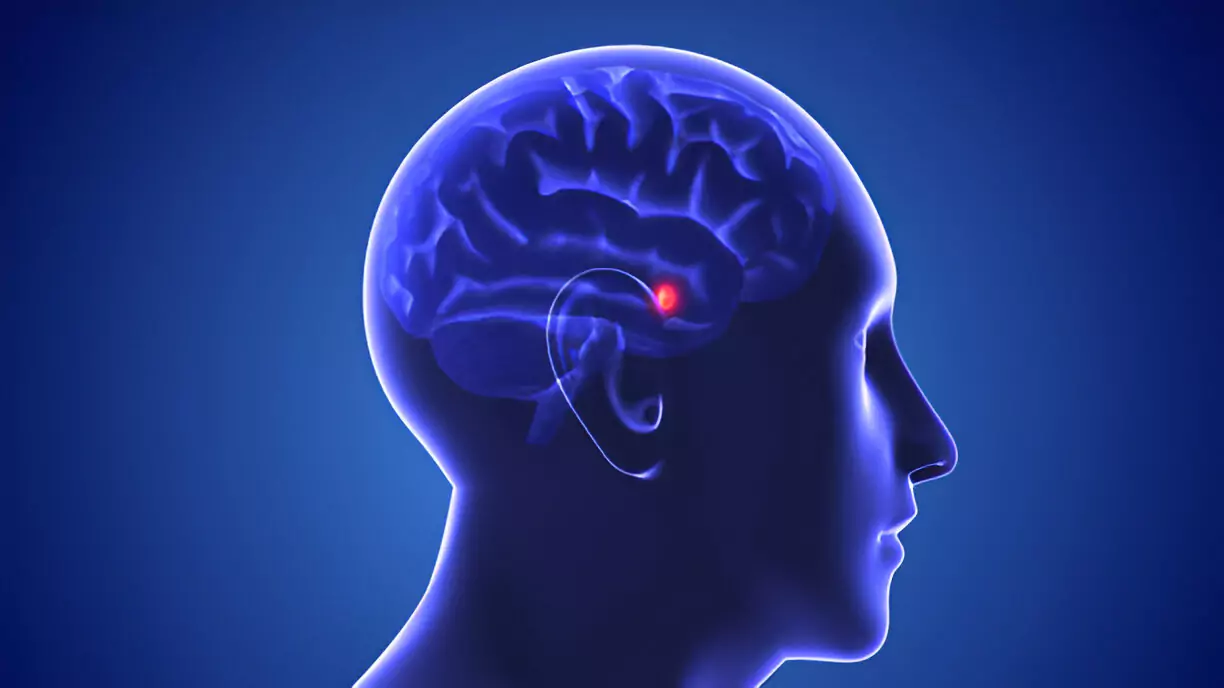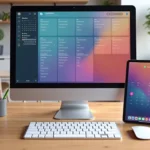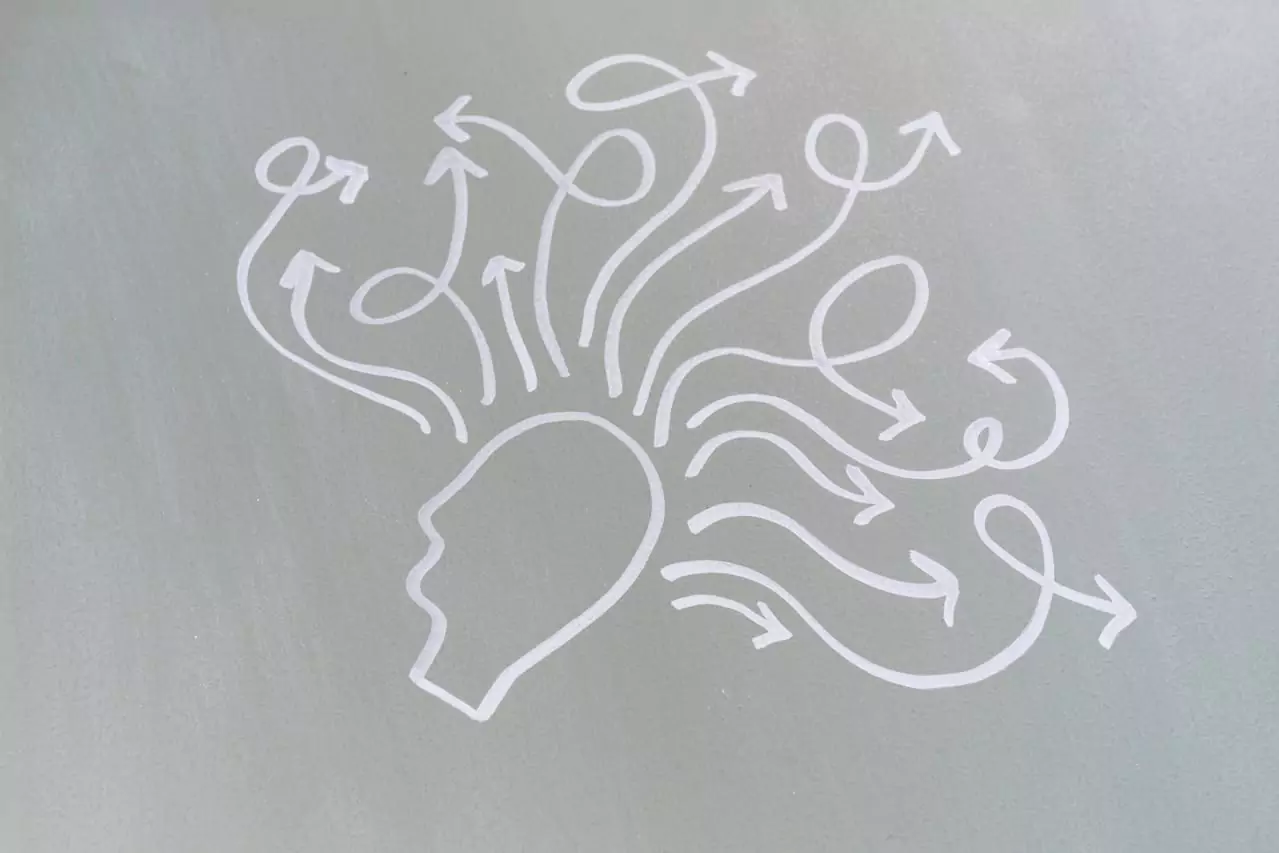Ever feel like your brain’s a browser with too many tabs open? Same here. Between grocery lists, work stuff, and random trivia, it’s easy to feel like your mental hard drive is full. That’s where chunking comes in—a super simple trick to make remembering things way easier. And trust me, it works like magic. Let’s dig in, shall we?
How Chunking Works

Think of chunking as giving your brain a helping hand. Instead of cramming it full of random bits, you’re grouping stuff together into patterns that make sense. The magic of chunking lies in how our brains handle connected information. Think of it like packing a suitcase: instead of shoving in random clothes, you fold and organize them into tidy stacks.
What Is a Typical Instance of Memory Chunking?
Ever use acronyms like HOMES for the Great Lakes (Huron, Ontario, Michigan, Erie, Superior)? That’s chunking! Or when you sort your shopping list by aisle—that’s chunking too. It’s a natural part of how we manage information without even realizing it.
Is There Any Research or Study on How Chunking Memory Works?
Study 1: Chunking and Verbal Short-Term Memory
Okay, this one’s like discovering your brain has its own filing system. The study looked at how chunking works in your short-term memory, especially with words. Here’s what they found:
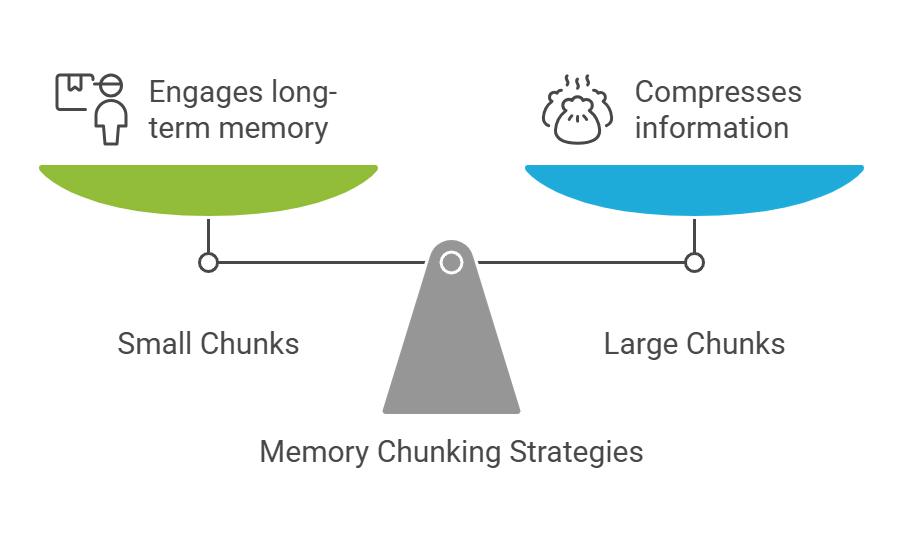
- Small Chunks vs. Big Chunks: If you group things into small chunks, like pairing two words together (e.g., “red car”), your brain pulls out tools from long-term memory to help. But if you go for larger chunks (say, three words like “big red car”), your brain compresses the info instead. Think of it as using a vacuum bag to shrink everything down.
- Why This Matters: It shows that chunking isn’t just one-size-fits-all. Your brain tailors how it handles chunks based on their size. Cool, right? It’s like having a super-smart personal assistant that knows the best way to organize your thoughts.
Study 2: How Chunking Helps Working Memory
This one’s all about the “magic trick” of chunking. You know that overwhelming feeling when you’ve got too much info flying at you? Chunking swoops in to save the day.

- The Magic: By grouping stuff together, your brain has fewer bits to juggle, which means less mental clutter. It’s like carrying groceries in a bag instead of balancing them in your arms—way easier, right?
- Takeaway: When you chunk info, your brain doesn’t just survive—it thrives. You can handle more, remember better, and feel like a mental superhero. Honestly, chunking is a life hack that deserves more credit.
Study 3: Chunking vs. Memory Overload (Proactive Interference)
Alright, here’s where things get really interesting. This study dug into why we sometimes mix up old info with new stuff. Ever call someone by the wrong name because it sounds similar to someone else? That’s proactive interference, and chunking can help fix it.
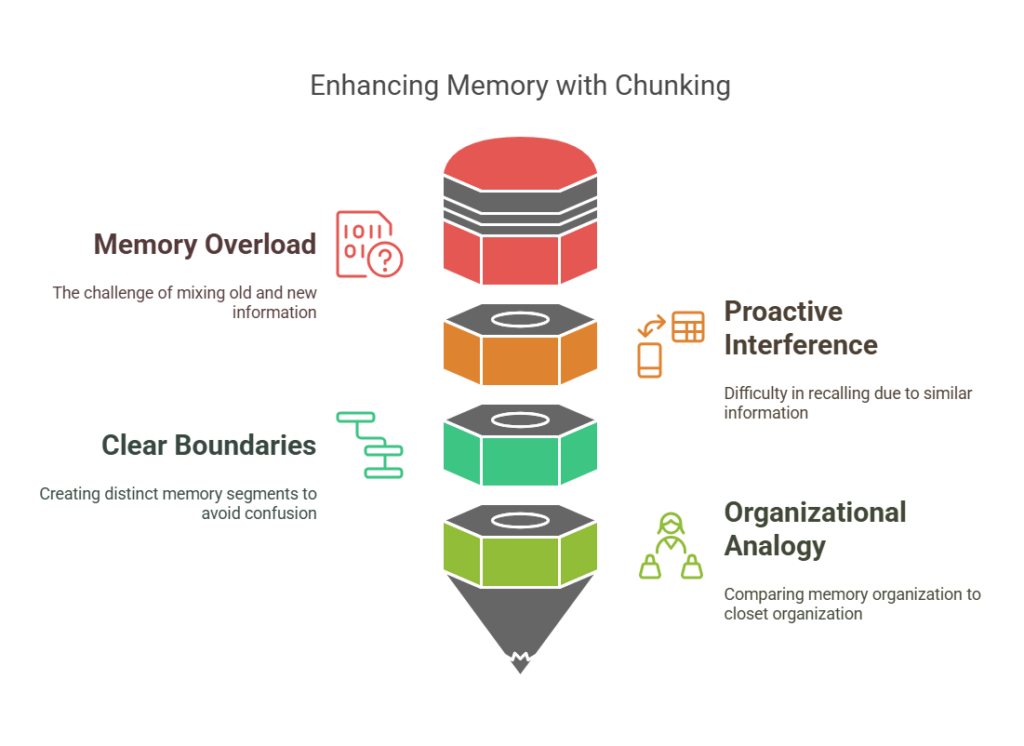
- The Fix: Chunking creates clear boundaries in your memory, like building fences around different pieces of info. That way, your brain doesn’t confuse one “chunk” with another. It’s like organizing your closet so your winter coats don’t get mixed up with summer dresses—much easier to find what you need.
- Why This Works: It shows chunking isn’t just about cramming more into your memory; it’s about making what you remember crystal clear, even when life gets messy.
What These Study Confirms
These studies don’t just tell us that chunking works—they explain why it works so well. Your brain has this incredible ability to group, compress, and organize information in ways that make learning and remembering easier. And the fact that it even has strategies to avoid confusion? That’s just pure brilliance.
Why Does Chunking Work?
Chunking works because your brain loves patterns and finds ways to simplify information by grouping it into manageable pieces, like turning a messy pile of groceries into a neatly packed bag. This reduces the mental load, freeing up brainpower for other tasks. Studies show chunking plays nicely with long-term memory, using it as a helper to connect and organize new information. It’s also a pro at busting confusion by separating similar data into distinct groups, so your brain doesn’t mix things up. Plus, chunking respects your brain’s limits—since you can only hold 5-9 pieces of info at a time, it works within that space to maximize efficiency. And the best part? It makes information stick. By giving data meaning and structure, like acronyms or mnemonics, chunking turns forgettable details into memorable stories. It’s your brain’s ultimate life hack, making recall faster, clearer, and way less stressful.
Examples of Chunking
1. Remembering Phone Numbers
The Struggle: Phone numbers are the ultimate brain teaser. A random string of 10 digits? Forget it. And let’s be real: most of us have become so reliant on our phones that memorizing numbers feels as outdated as carrying a pager.
The Fix: Break the digits into smaller, bite-sized chunks. Instead of trying to memorize 9876543210, think of it as 987-654-3210. It’s like turning a marathon into three manageable sprints.
Let’s Spice It Up:
- Associate with landmarks: Maybe 987 reminds you of your area code or the year you graduated high school. Find personal connections to make the numbers stick.
- Sing it out: Ever noticed how jingles on the radio are impossible to forget? Turn that phone number into a catchy tune.
- Write it repeatedly: Channel your inner high school student and scribble the number a few times. Writing engages your muscle memory, giving your brain extra help.
2. Learning Vocabulary in a New Language
The Struggle: Staring at a long list of words like “apple,” “bear,” and “dance” in a foreign language feels like trying to solve a crossword without any clues. It’s hard to find a rhythm when nothing connects.
The Fix: Group related words together. Want to remember “apple” in French (“pomme”)? Pair it with other fruit words like “banane” (banana) and “raisin” (grape). Now you’re building a category that sticks.
Make It Fun:
- Picture a story: Imagine a banana and an apple going to a party with a bunch of grapes. It’s goofy, but your brain loves stories.
- Gamify it: Apps like Duolingo and Memrise are lifesavers. Turn vocabulary into a game, and suddenly, “studying” becomes “fun.”
- Use it IRL: When you spot an apple, say “pomme” instead of apple. Sure, people might look at you funny, but you’ll remember it!
3. Memorizing Shopping Lists
The Struggle: By the time you’ve reached the frozen aisle, you’ve forgotten whether you needed broccoli or Brussels sprouts. Cue the double purchase—or worse, forgetting both.
The Fix: Group your list into categories. Think “dairy” (milk, cheese, eggs), “produce” (spinach, carrots, apples), and “meat” (chicken, beef). Now you’re shopping like a pro.
Pro Moves:
- Visualize the store: Picture your grocery store layout and “walk” through it in your mind. This mental map anchors your memory.
- Create acronyms: For a produce-heavy list, think “CAB” for carrots, apples, and bananas. It’s like a cheat code for your brain.
- Tech it up: Apps like AnyList organize your shopping by aisle—perfect if you hate doubling back for that forgotten jar of salsa.
4. Studying for Exams
The Struggle: Your textbook is thicker than a dictionary, and every page feels like it’s mocking you. Where do you even start?
The Fix: Break material into themes or chapters. Studying biology? Tackle “cell structure” one day and “human organs” the next. Treat each section like its own mini-quiz.
Ace Your Prep:
- Mind maps: Create a spiderweb of connected ideas. It’s like doodling, but smarter.
- Teach it: Grab a friend (or a patient pet) and explain the material. If you can teach it, you know it.
- Mix in breaks: Use the Pomodoro Technique—study for 25 minutes, chill for 5. Your brain will thank you.
5. Memorizing Passwords
The Struggle: Between “Pa$$word123” and “Xyz!@456,” your passwords feel more like a Rubik’s cube than something you’re supposed to remember.
The Fix: Chunk it up. Instead of staring at “Abc123Xyz456,” break it into “Abc-123-Xyz-456.” Now it’s manageable.
Extra Credit:
- Find meaning: Turn “Abc” into “Always Be Cool” and “123” into your favorite countdown.
- Picture a scene: Visualize “Xyz” as a superhero—cape and all—saving the day. Corny? Yes. Effective? Also yes.
- Use tech wisely: Password managers like LastPass store all your secrets, so you only need to remember one master password.
6. Learning to Play Music
The Struggle: That guitar solo isn’t going to learn itself, but every time you try, it feels like your fingers are playing a practical joke on you.
The Fix: Break the song into sections: verse, chorus, bridge. Focus on one part until you nail it, then move on.
Jam Session Tips:
- Slow it down: Play at half speed. Nail the notes, then ramp up the tempo.
- Loop the tough spots: Got a tricky chord change? Repeat it until your fingers move on autopilot.
- Celebrate progress: Record yourself. Hearing how far you’ve come is the ultimate motivator.
7. Following Directions
The Struggle: “Turn right, then left, then… wait, was it another left?” Directions vanish faster than a Snapchat message.
The Fix: Chunk steps into pairs: “Turn right, then left” becomes one mental unit. Focus on that before moving to the next.
Never Get Lost Again:
- Landmark it: Instead of memorizing turns, remember “Turn left at the giant coffee shop.”
- Draw it out: A quick doodle of the route can be a lifesaver.
- Repeat out loud: Saying directions helps cement them in your memory. (Bonus: It looks like you’re talking to your GPS.)
8. Remembering a Speech or Presentation
The Struggle: Forget one line, and the whole speech feels like a house of cards collapsing. Cue the panic.
The Fix: Break your speech into key sections. Memorize the flow of ideas, not the exact words.
Take the Stage:
- Tell stories: People remember stories, not stats. Share an anecdote to keep your audience engaged.
- Use cue cards: Jot down key points. It’s your safety net if your mind goes blank.
- Practice under pressure: Rehearse in front of a mirror, a friend, or even your dog. The more comfortable you are, the less intimidating the real thing will feel.
9. Cooking Recipes
The Struggle: Halfway through a recipe, you realize you skipped Step 4. Oops. Now your cake looks more like a pancake.
The Fix: Divide the recipe into stages: prep, cook, garnish. Tackle each step like a mini-project.
Chef Hacks:
- Prep it all: Lay out ingredients before you start. Cooking is easier when everything’s ready to go.
- Cross it off: Treat your recipe like a checklist. Crossing off steps feels oddly satisfying.
- Channel your inner pro: Watch cooking videos to see how chefs sequence their actions. Gordon Ramsay wouldn’t forget the marinade, and now, neither will you.
10. Improving Athletic Performance (e.g., Gym Routines)
The Struggle: Keeping track of sets, reps, and exercises feels like mental gymnastics. Add in a crowded gym, and it’s chaos.
The Fix: Chunk your workout into sections: warm-up, strength, cardio, cool-down. Focus on one block at a time.
Crush Your Workout:
- Plan ahead: Write your routine down or use a fitness app. It keeps you on track.
- Mini-goals: Instead of “Finish the workout,” aim to “Crush this set.” Small wins build momentum.
- Switch it up: Alternate between exercises to keep it interesting. Boredom is the real enemy.
How to Use Chunking to Boost Your Memory
Using chunking is like mastering a life hack. Start by grouping similar information—like putting socks with socks and shirts with shirts. Studying for a test? Break the material into smaller sections by topic. Learning a new skill? Tackle it step by step. And don’t forget to practice—the more you use it, the better you get.

Practice Chunking
Think of chunking as a muscle—the more you flex it, the stronger it gets. Apps like Quizlet or Anki are great for practicing. Try grouping vocabulary, historical dates, or even your shopping list. And here’s a fun challenge: recall grouped information while walking or doing chores. Multitasking for the win!
Look for Connections
Your brain loves connections like a kid loves candy. When you link ideas together, they’re easier to remember. Studying history? Tie events to a timeline. Learning a language? Group words into themes like food, travel, or emotions. It’s all about building a web of meaning that sticks.
Make Associations
This is where the fun begins. Associations turn boring facts into unforgettable memories. Mnemonics are classics for a reason—“Every Good Boy Deserves Fudge” for musical notes, anyone? Visualization works too. Imagine an apple juggling bananas to remember fruit categories. The sillier, the better—your brain loves a good laugh.
Combine Other Memory Strategies With Chunking
Chunking is a team player. Pair it with spaced repetition (reviewing chunks over time), and you’ve got a memory powerhouse. Mind mapping helps you visualize chunks and their connections, while storytelling turns chunks into memorable narratives. It’s like turning up the volume on your memory’s greatest hits.
Final Thoughts
Improving short-term memory doesn’t have to feel like solving a Rubik’s cube blindfolded. With chunking, you’re giving your brain a well-deserved breather. Whether it’s acing an exam, cooking dinner, or remembering why you walked into that room, these strategies make life just a little easier. Start small, laugh at yourself, and watch your memory go from zero to hero—one chunk at a time.
FAQs
What is chunking psychology in simple terms?
Chunking is a memory technique where you group information into smaller, meaningful units, making it easier to remember.
How does chunking help improve short-term memory?
It reduces cognitive load by organizing data into manageable chunks, allowing your brain to process and recall information more efficiently.
Can chunking improve long-term memory too?
Yes, when paired with repetition and meaningful associations, chunking can aid long-term retention.
Is chunking effective for everyone?
Most people benefit from chunking, but its success depends on how well the information can be grouped into logical or relatable units.
What types of information work best for chunking?
Chunking works best with structured or pattern-based data, such as numbers, lists, or related concepts. Abstract or unrelated information may require additional techniques.
How does chunking differ from other memory techniques?
Unlike rote memorization or visualization, chunking focuses on organizing information into smaller, cohesive groups, leveraging patterns for easier recall.
Is chunking a natural process, or does it require practice?
Our brains naturally chunk information, but deliberate practice can improve its effectiveness, especially for complex data.
Can chunking be used for multitasking?
Yes, chunking helps streamline memory use, which can improve multitasking by reducing mental overload.
How does chunking relate to focus and attention?
By reducing the amount of information the brain needs to process, chunking improves focus and minimizes distractions.
Image source-pexels
References
- “Chunking and Redintegration in Verbal Short-Term Memory”
- “How Does Chunking Help Working Memory?”
- “The Role of Chunking and Proactive Interference in Working Memory”


